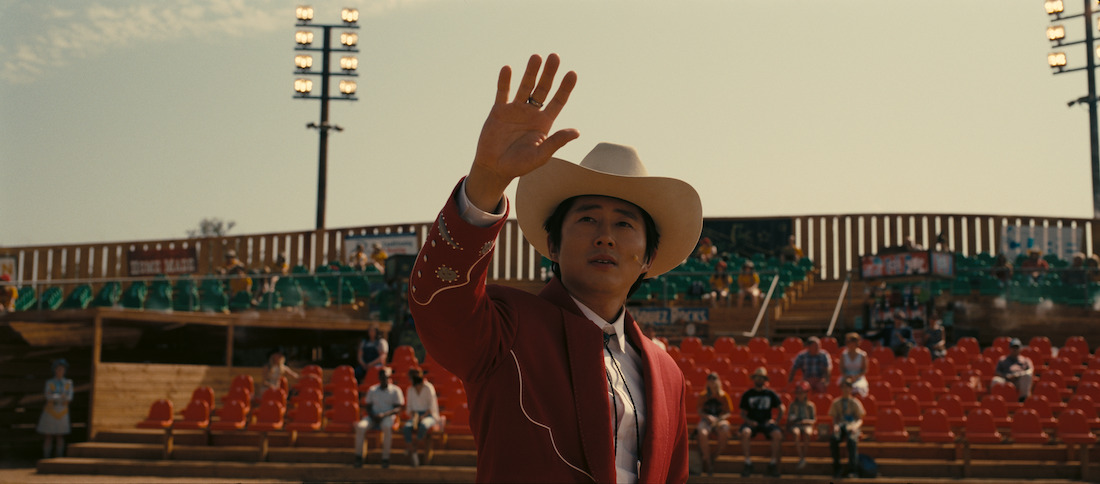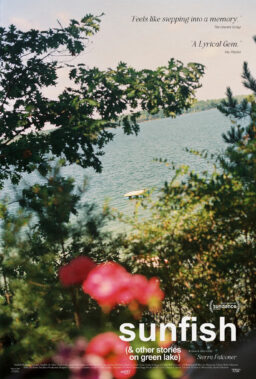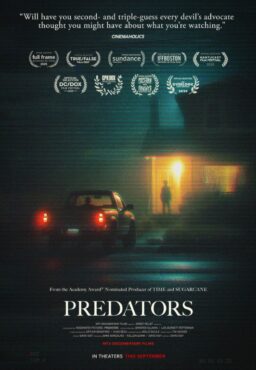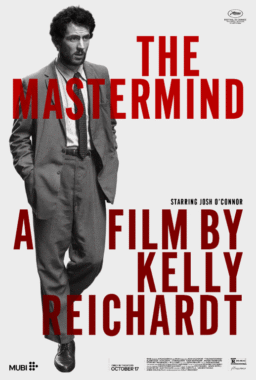A modern cowboy, a Black man in an orange hoodie, sits astride a horse, facing forward in a medium shot. He points two fingers at his eyes, then points at the camera, signaling his sister—and us too.
I see you.
“Nope,” Jordan Peele’s latest film, is about looking—and being seen. The writer/director (“Get Out,” “Us”) reminds us of this through the motif of mirrors, cameras, and eyes, evoking ideas about representation, erasure, and power.
Peele has said “Nope” is about spectacle, what he’s called “the human need to see something crazy,” and how we monetize that. But what else is a spectacle except what you can’t help watch? The motorists clogging traffic to check out a car wreck. The selfies and online videos delivering stunts and more we hope people want to see.
There’s an uneasy, alien relationship between our desire for such novelty and the urge to package it, market it, and cash in on it. We like to watch—and make sure others are watching too.
“So much of this is about the violence of attention,” Peele has said. “In a lot of ways, this is a reflection of all these different sides of this industry of the spectacle that I’ve been on … and me trying to be upfront with my part in it and at the same time live my life and tell my story and do my thing.”
(Spoilers follow.)
“Nope” opens with violence: the carnage from “Gordy’s Home,” a 1990s-era sitcom (apparently modeled on the 1980s interracial adoption sitcoms like “Diff’rent Strokes” and “Webster”) where the chimpanzee star mauled and killed actors—a seemingly out-of-context start whose connection to the main story will become clearer later. We meet the cowboy, OJ (Daniel Kaluuya), a Hollywood horse trainer like his father, Otis Haywood Sr. (Keith David). The Haywoods, including OJ’s sister, Emerald (Keke Palmer), are descendants of a man seen but largely ignored: the Black jockey riding a racehorse in Eadweard Muybridge’s 1878 short, the first film ever made.
One sunny day, debris rains from the sky. Keys and other things ping off the ranch fencing. Otis Sr. collapses, dead; a nickel sliced through his eye. The poor man never saw it coming. OJ hangs it in a baggie on the wall, where he can’t help but see it. His father spent his life helping Hollywood create spectacles, and he’s cut down by a nickel, his life worth less than pocket change.

After his death, OJ and Emerald try to rustle up business. OJ, uncomfortable meeting people’s eyes, pats and murmurs to a horse on a commercial set, soothing himself as much as the animal. Emerald exuberantly introduces their heritage and safety rules, then adds how she sings, dances, and sews. OJ chides her for promoting her side hustles, but she fires back that to her, the ranch is a side hustle. She wants to be seen.
When a crew member sets a mirror in front of their horse, the reflection spooks the animal, costing them the job. Soon, that thing in the sky snatches a horse or two. OJ thinks whatever it is could be their ticket to saving what their father built. So he and Emerald decide to shoot it—but not with a weapon. They hit the local electronics store to rustle up a high-tech camera system to get what they call “the Oprah shot”—the money shot. Nothing is real if you don’t have proof of it, if someone doesn’t see it.
Angel (Brandon Perea), a curious techie, joins them, along with the commercial director, Antlers Holst (Michael Wincott), whom Emerald entices with the chance of “the impossible shot.” He warns her: “This dream you’re chasing, where you end up at the top of the mountain? It’s the one you never wake up from.”
Former child star Ricky “Jupe” Park (Steven Yeun) knows that dream. He played a kid sheriff in one show and in “Gordy’s Home,” he was the adopted Asian child in a white family on a sitcom in which Gordy, the chimp, was the real star. He survived the “Gordy’s Home” rampage, physically at least, and now runs Jupiter’s Claim, a kitschy Western attraction down the road from the Haywoods’ ranch. Its mascot is a winking inflatable cowboy, and its souvenir photos are taken by a camera in a wishing well. Emerald photobombs one by accident.
Capitalizing on people’s curiosity, Jupe keeps a secret room of “Gordy’s Home” memorabilia, including a sneaker with a drop of blood, for fans to pay to admire—a way to monetize his pain, like the Haywoods are trying to do—but he’s literally put himself in a box, unable to break away from how others see him.
He also hosts a spectacle, the “Star Lasso Experience,” where he welcomes that thing in the sky by feeding it horses OJ sold him. First, he introduces a former “Gordy’s Home” co-star, her maimed face hidden behind a veil. She wears a sweatshirt with the smiling photo of the teenage girl she used to be: how she wants to be seen.
Jupe tells his audience about the alien presence he calls “The Viewers,” who in his mind look like the cameras he’s seen for most of his life. A flashback shows him hiding on the “Gordy’s Home” set under a table. The shape of the film magazines atop the abandoned cameras resemble the alien plush figures and masks that present-day Jupe sells.
Back then, Gordy looked right at Jupe—and us, the camera acting as Jupe’s point of view. Its gaze inscrutable, its mouth bloody, the chimp drew closer, reaching its knuckles toward Gordy. Did it sense a kindred spirit? Or would it have harmed him? Rescuers shoot it before Jupe can find out.
Jupe as a boy had no control. Through the theme park and the alien show, he seems to have control now—but it’s false, just like the trainers on “Gordy’s Home” thought before Gordy snapped. Before OJ’s horse saw its reflection and startled.
Attention can be a beast. It might feel warm, flattering, euphoric. But it can change, like the creature does: from the silvery flying saucer of so many films to something pliable, expansive, with a gaping maw that looks like a black hole.
All this attention literally engulfs Jupe. As he and the apprehensive crowd stare up at it, unable to look away, the alien entity opens its mouth like an aperture, devouring Jupe and his audience whole. Peele shows them struggling inside this creature, fighting against folds of tissue, and we realize we’ve seen this before, over the opening credits: a billowing “tunnel” that rippled like curtains.
We were in the belly of the beast then. We just didn’t know it.
This creature likes to watch, too—to a point. It’s drawn to whatever looks at it, making us the focus that mesmerizes. It feeds on our attention, though never on itself, inhaling anything and everything it can before chucking what it can’t use. I will cast abominable filth at you, make you vile, and make you a spectacle, says the biblical quote (Nahum 3:6) that Peele uses to open the film, and after visiting Jupiter’s Claim, the creature delivers a deluge of filth, parking in the sky right above the Haywoods’ ranch house and spewing out blood, metal, and other debris. It literally chews people up, absorbing only what it needs for sustenance and ejecting the rest, indiscriminate in its damage.
Don’t look at it, OJ warns, thinking of animal behavior, but it’s something actors learn, too: where and when to look. He covers his horse’s head with a blinker hood and pulls up a hoodie to guard his own eyes—orange crew gear from “The Scorpion King,” the film shoot where young OJ was inducted into the Hollywood economy by his father, and another chance for the family business that didn’t work out (the filmmakers sidelined their horses for camels instead). OJ gallops out as bait so Holst can get the shot, but their plan goes sideways. A tabloid photographer, all silvery helmet and shiny motorcycle, like the creature in miniature or the mirror that startled the horse, drives into harm’s way. The creature sucks him up along with Holst, who got the shot after chasing higher ground, hoping to top the impossible. His dream ends on top of a mountain.
Eventually, the creature changes shape, all diaphanous loops with a square green eye that peels back curtain after curtain, like an early viewfinder—or as if unveiling another show. OJ signals to Emerald—I see you—and makes one last ride so she can escape, but she signals back at him.
I see you. I got you.

Don’t all of us want to be seen? Cinephiles notice when a film has a female gaze or a different gaze from what we’ve long consumed. Through three horror films, Peele has made sure we see Black characters in a way we haven’t before: casting them in the spotlight instead of the margins, eschewing the trope where they’re among the first to die. A filmmaker’s gaze gives a camera power, showing us who’s the predator and the prey, but there’s also power in where we decide not to look.
Emerald figures out a way to get the money shot, feeding coin after coin into the Jupiter’s Claim wishing well, luring the creature with that winking inflatable balloon—something it swallows but then can’t stomach. A photobomb of another sort.
But ultimately, she doesn’t care. She’s too relieved to see OJ, alive. They both survive because they looked out for each other, realizing that you can’t chase the spectacle or stare into the abyss forever.
Sometimes the darkness stares back.











